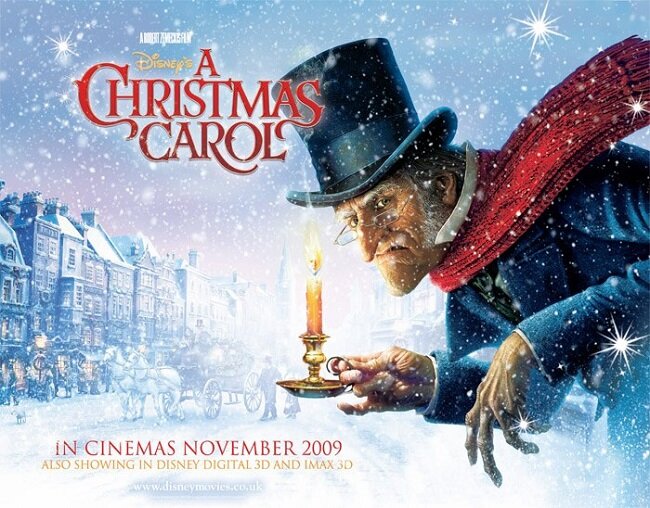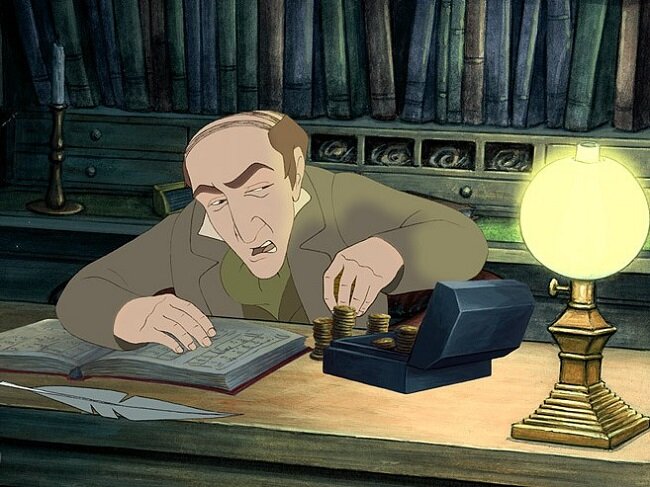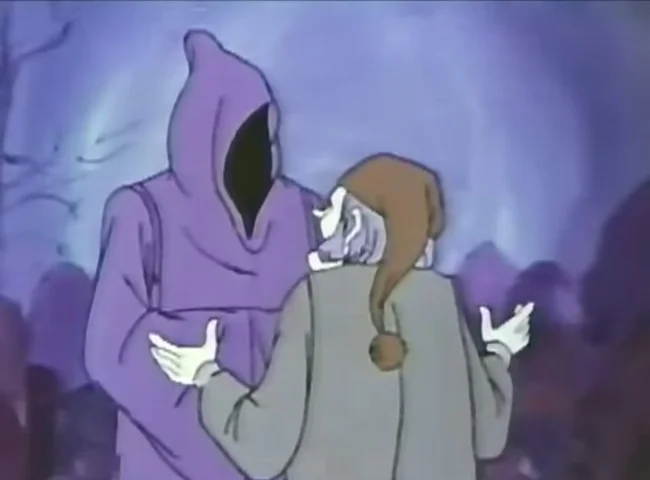Scrooge (1935)
This 1935 British adaptation of Dickens’ classic book was the first movie version of the story to have sound. Director Henry Edwards had to work creatively to stretch the productions modest budget. Subsequently the production is reliant on fog and snow shrouded sets, mainly to keep costs down. However, this does provide a veneer of authenticity in its depiction of a divided and polluted London. There are a few miniature shots showing the capital city at night and a handful of location shots inside various public buildings to establish the period setting. But mainly this is a set bound production and a sombre one at that. The underlying thrust of this adaptation is to highlight the class division as well as the contrasting wealth and poverty of the country at the time. It is this perspective that is used as the fulcrum of Scrooge’s redemption.
Seymour Hicks plays Ebenezer Scrooge. A distinguished actor from the Edwardian era his initial portrayal of iconic miser is both petulant and terse. Whereas Bob Cratchit (Donald Calthrop) is depicted as a dominated man who fears for his situation. Unlike other productions, this one spends more time focusing on the different social classes inhabiting the capital. We see Scrooge’s nephew Fred buying Christmas provisions and entering into the spirit of the season. This is then offset against Scrooge taking a lonely meal on his own. Bob Cratchits meagre yuletide provisions and his family’s poverty are then contrasted by the rich gathering at a Lord Mayor’s banquet. The screenplay also spends more time building up to Jacob Marley’s visit. This is quite a tense and atmospheric stretch of the film. It has a hint of gothic horror about it and is well contrived.
Sadly, possibly for budgetary reasons, Marley’s ghost can only be seen by Scrooge. We hear his voice but see only doors open and Scrooge addressing an empty chair. This approach does diminish the power of the scene. The next Ghost, the Spirit of Christmas Past is merely a glowing shape of a man. The screenplay then proceeds to abridge much of the source text and we see nothing of Scrooge’s school days or apprenticeship with Fezziwig. We simply go straight to the termination of Scrooge’s engagement. The Spirit of Christmas Present (Oscar Asche) is thankfully a physical being and sticks to the traditional depiction of the character. The Ghost of Christmas Yet to Come is shown as the silhouette of pointing hand. There are a few optical effects to embellish these later scenes. Again, at this stage of the story, the screenplay further condenses much of narrative. Scrooge himself becomes quite complaint by his second ghostly visit.
Yet despite the various omissions of certain iconic scenes, the script still keeps occasional snatches of dialogue direct from the book. Bob Cratchit jests about the possibility of someone climbing over the back wall and stealing the family’s Christmas pudding. We also get a montage of how everyday people celebrate the meaning of Christmas. We see both a ship’s crew at sea and two remote lighthouse keepers exchanging season’s greetings. The movie takes a second turn towards the sinister when the Housekeeper, the Washer Woman and Undertaker meet up at Old Joe’s pawn shop and hawk the wears they’ve plundered from a dead Scrooge. It is atmospheric and shot in a rather menacing and baroque fashion. It makes its point well. It should also be noted that this is one of a handful of adaptations that shows Bob Cratchit mourning over the actual body of a dead Tiny Tim. It is both a tragic and rather stark scene.
The climax of the film focuses very much on a joyous and genuinely happy Scrooge. The screenplay makes it very clear that this is about his spiritual salvation, rather than just an old miser discovering the joy of helping others. We see Scrooge visit his nephew, but the focus is more upon his compulsion to help Bob Cratchit. When he sees him at work the following day their redefined relationship culminates in a visit to church with an emphasis upon spiritual conversion. All of which would work fine as an ending, if Scrooge’s character transformation hadn’t had been so abrupt. The tipping point comes to early during the film and is made too clear, so therefore lacks nuance. However, the film is still of note for attempting to depict the fundamental inequalities made clear in original story. Scrooge is surprisingly bleak, tonally quite grim and doesn’t sanitise the notion of poverty.
NB. This movie has been in and out of the public domain for many a year. There is a truncated US version that runs just 63 minutes and the longer UK edit that I watched that runs 78 minutes. Many prints that are in circulation are in very poor condition. The US release is also available in a colourised edition. However, there was a full restoration undertaken by Renown Pictures in 2009 which is available on Amazon Prime in the UK. This version by far offers the best picture quality and is the one I would recommend people to watch.

















